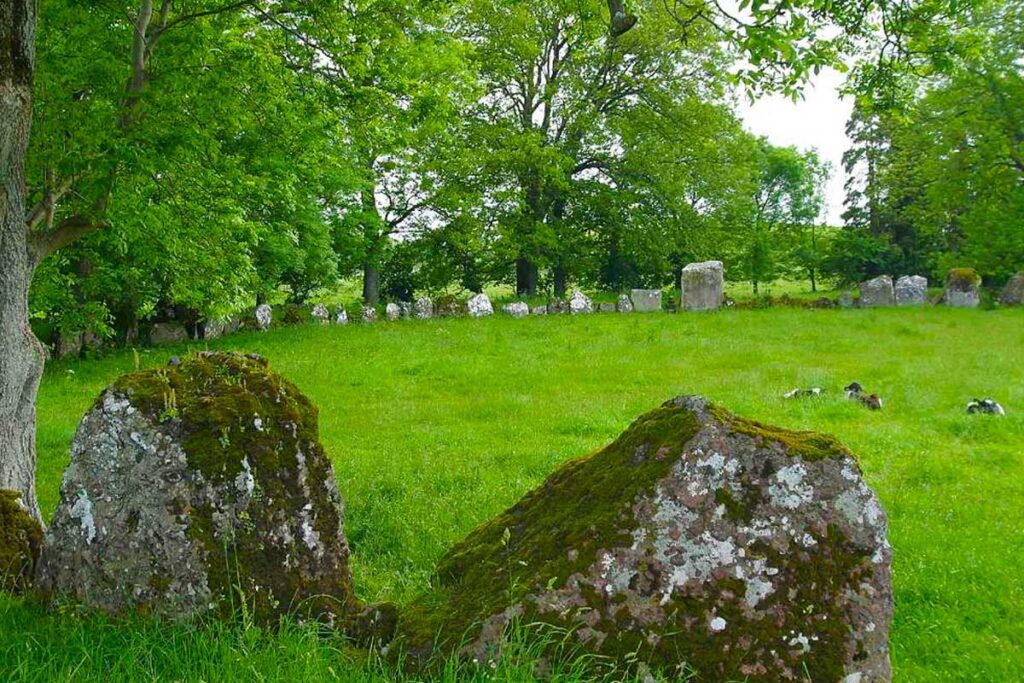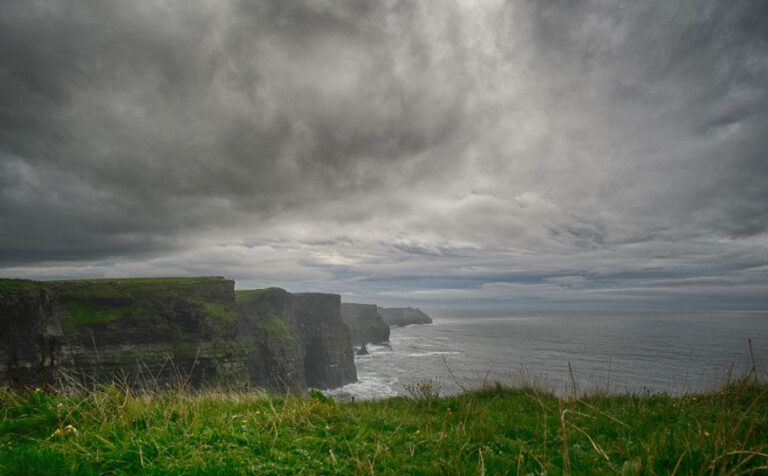Ireland, a land steeped in history and mystique, holds within its folds a treasure trove of archaeological wonders. Among these, the Lough Gur Archaeological Site stands out as a testament to Ireland’s prehistoric past. Nestled in the lush landscape of County Limerick, Lough Gur offers a captivating journey through time, unraveling the mysteries of ancient civilizations that once thrived in this picturesque setting.
Unveiling the Enigmatic Lough Gur
Lough Gur, a serene lake nestled amid the undulating hills of County Limerick, emerges as an idyllic backdrop for unraveling the mysteries of Ireland’s past. This natural haven, cradled by its picturesque surroundings, serves as the canvas upon which an ancient tapestry unfolds, capturing the imagination of those drawn to its tranquility and historical richness.
The archaeological site encircling the lake’s periphery has become a focal point of exploration, attracting not only seasoned archaeologists and historians but also sparking the curiosity of inquisitive visitors from around the world. Lough Gur’s allure lies not just in its scenic beauty but in the layers of time that lie embedded in its soil, waiting to be unearthed and interpreted.
As one approaches the shores of Lough Gur, there is a palpable sense of stepping into a realm where the echoes of the past reverberate through the landscape. Archaeologists have meticulously excavated and studied the site, unearthing artifacts and structures that offer a compelling narrative of the various civilizations that have called this region home over millennia.
The rich historical significance of Lough Gur unfolds like chapters in a captivating story, each layer of earth holding clues to the lives, customs, and rituals of the people who once inhabited this verdant landscape. From the earliest traces of prehistoric settlements to the medieval period, the archaeological record at Lough Gur provides a comprehensive chronicle of human existence and evolution.
The lake itself, with its still waters reflecting the changing hues of the sky, serves as a mirror to the past. The archaeological endeavors around Lough Gur have revealed not just the physical remnants of structures but also the intangible traces of a bygone era – the spiritual practices, social dynamics, and cultural expressions that shaped the lives of those who flourished here.
The meticulous excavation and documentation of artifacts, from pottery fragments to tools and ornaments, contribute to piecing together the puzzle of Lough Gur’s history. The careful analysis of these findings allows researchers to reconstruct the daily lives and societal structures of ancient communities, shedding light on their technological achievements and artistic expressions.
Visitors to Lough Gur are afforded the opportunity to engage with history in a tangible and immersive way. Walking along the lake’s edge, they become part of the unfolding narrative, surrounded by the same landscapes that witnessed the triumphs and challenges of past civilizations. The enigmatic aura of Lough Gur transcends the boundaries of time, inviting contemplation and reflection on the enduring connections between the past and the present.
In essence, Lough Gur stands not just as an archaeological site but as a living testament to the resilience and ingenuity of humanity across the ages. It beckons explorers and history enthusiasts to embark on a journey through time, peeling back the layers of history that have shaped this enchanting corner of Ireland. As the sun sets over the tranquil waters of Lough Gur, the whispers of antiquity linger, inviting all who visit to partake in the timeless dance between nature and history.
Prehistoric Settlements
The Lough Gur region, with its serene beauty nestled amidst rolling hills in County Limerick, serves as a remarkable testament to the enduring connection between humans and the Irish landscape. Stretching back over an impressive span of 6,000 years, this region holds evidence of continuous human habitation, providing a captivating window into the rich tapestry of Ireland’s prehistoric past.
Prehistoric settlements dot the landscape, forming a mosaic of historical remnants that whisper tales of the early inhabitants who carved out their existence in this lush environment. Among these settlements, stone circles stand as silent witnesses to ceremonies and gatherings that played a central role in the lives of the people who once called Lough Gur home. The perfectly aligned stones, dating back to epochs long past, reveal a society attuned to celestial rhythms, where spiritual practices intertwined with the natural world.
Burial mounds, scattered across the region, mark the final resting places of those who lived in ancient times. These solemn structures, with their enigmatic contents, provide insights into burial practices, societal structures, and perhaps even the beliefs surrounding the afterlife. Excavations around these burial mounds unveil artifacts that not only speak of the reverence for the departed but also offer glimpses into the craftsmanship and artistic expressions of prehistoric communities.
Dwelling sites, discovered along the shores of Lough Gur, give us a tangible sense of the daily lives of Ireland’s early inhabitants. From simple circular huts to more complex structures, these dwellings reflect the adaptability and resourcefulness of a people intimately connected to the rhythms of nature. The layout and construction of these homes offer valuable insights into architectural techniques, community organization, and the practical aspects of daily living.
Excavations in the Lough Gur region have unearthed a treasure trove of artifacts that act as silent storytellers of bygone eras. Tools crafted from stone and bone speak to the technological advancements of these ancient communities, revealing a mastery of craftsmanship that enabled survival in a challenging environment. Pottery, with its intricate designs, not only served utilitarian purposes but also showcased the artistic sensibilities of a people whose creativity flourished in harmony with nature.
Beyond the physical remnants, the archaeological record at Lough Gur unveils the rituals and customs that wove the fabric of prehistoric societies. Whether through the careful placement of stones in circles or the meticulous arrangement of artifacts in burial sites, these practices provide a glimpse into the spiritual dimensions that enriched the lives of these early inhabitants.
In essence, the prehistoric settlements around Lough Gur offer a profound and immersive journey into Ireland’s ancient past. As one walks the landscapes where these early communities thrived, the echoes of their existence resonate, forging a timeless connection between contemporary visitors and the resilient spirits of those who, millennia ago, shaped the cultural heritage of this captivating region.
The Grange Stone Circle: A Portal to Ireland’s Bronze Age Mysteries
At the heart of the Lough Gur archaeological site lies a mesmerizing testament to Ireland’s ancient past – the Grange Stone Circle. This awe-inspiring monument, believed to be a ceremonial and ritualistic gathering place, beckons visitors to traverse the annals of time and connect with a society deeply attuned to celestial rhythms and spiritual practices. The Grange Stone Circle stands as an enduring relic, a silent witness to the rituals and beliefs that once animated the landscape during the Bronze Age.
The Grange Stone Circle, a concentric arrangement of upright stones, exudes an aura of mystery and significance. Dating back to the Bronze Age, these carefully placed monoliths serve as both architectural marvels and conduits to the spiritual realm. The precision with which these stones are aligned suggests a profound understanding of astronomy, with the layout likely mirroring celestial events or marking significant points in the solar or lunar cycles.
As visitors approach the Grange Stone Circle, they are greeted by the imposing presence of these ancient sentinels. The sheer size and weight of the stones evoke a sense of reverence, inviting contemplation on the methods employed by the ancient builders to transport and position these colossal monuments. Each stone seems to carry the weight of centuries, bearing witness to the passage of time and the rituals that unfolded within this sacred space.
The circle’s layout is not arbitrary; it reflects a deliberate and intricate design that likely held symbolic and spiritual significance for the Bronze Age community. The circular form itself is often associated with ideas of cyclical nature, eternity, and the interconnectedness of life. The arrangement of stones may have served as an astronomical calendar or a venue for communal gatherings and ceremonies that marked seasonal transitions or celestial events.
Wandering amidst the Grange Stone Circle, visitors are enveloped in an atmosphere charged with historical resonance. The energy of the sacred space is palpable, fostering a connection with the spiritual practices of a bygone era. Some may feel a sense of transcendence, as if the barriers between past and present momentarily dissolve, allowing for a deeper understanding of the cultural and religious dimensions that shaped the lives of those who once stood within this circle.
The archaeological exploration of the Grange Stone Circle has yielded not only insights into the architectural prowess of the Bronze Age society but also artifacts that hint at the rituals conducted within its confines. Excavations have uncovered offerings, tools, and ceremonial objects, providing a glimpse into the symbolic language and practices of the people who gathered here for millennia.

Dolmen and Wedge Tombs
Lough Gur, cradled within the embrace of County Limerick’s picturesque landscapes, reveals not only the remnants of prehistoric settlements but also boasts impressive dolmens and wedge tombs that stand as silent sentinels to the rituals and burial practices of Neolithic communities. These megalithic structures, strategically positioned across the landscape, weave a narrative of a society with a profound understanding of both architecture and symbolic significance.
Dolmens, characterized by their massive stone slabs forming a chamber supported by upright stones, grace the Lough Gur region with their enigmatic presence. These structures are intrinsically linked to the burial customs of ancient communities, providing a final resting place for individuals whose stories are now shrouded in the mists of time. The strategic placement of dolmens within the landscape suggests a deliberate consideration of celestial alignments or natural features, indicating a sophisticated knowledge that surpassed mere practicality.
Wedge tombs, another remarkable feature of Lough Gur, bear witness to the Neolithic communities’ reverence for the deceased. These tombs, characterized by their wedge-shaped chambers, exemplify a careful design that reflects both functional considerations and symbolic meaning. The positioning of these tombs across the landscape forms a silent testimony to the intentional integration of these structures within the broader cultural and natural context.
As one wanders among these dolmens and wedge tombs, the whispering winds seem to carry echoes of the ancient tales of those laid to rest within. The imposing stones, weathered by centuries, stand as witnesses to the passage of time, preserving the solemnity of the burial practices carried out by communities whose spiritual beliefs and cultural expressions are now deciphered through the lens of archaeology.
The dolmens and wedge tombs at Lough Gur, beyond their utilitarian roles, serve as artistic expressions of a society that invested not only in practical considerations but also in the symbolic language of death and the afterlife. The megalithic monuments, aligned with the natural features of the landscape, create an interplay between the constructed and the natural, embodying a holistic worldview where the spiritual and earthly realms converge.
In contemplating these structures, visitors may sense a connection with the profound rituals enacted by the ancient inhabitants of Lough Gur. The dolmens and wedge tombs, standing as guardians of the past, invite reflection on the continuity of human practices related to death, remembrance, and the enduring significance of these sacred spaces within the cultural memory of Ireland. Lough Gur, with its dolmens and wedge tombs, becomes a gateway to a time when the landscape served as both a canvas and a repository for the stories of those who shaped the ancient tapestry of this captivating region.
The Crannogs
Nestled within the waters of Lough Gur, the crannogs stand as unique and intriguing features, weaving a tale of human ingenuity and adaptability during the medieval period. These artificial islands, constructed on the lake’s surface, represent a fascinating chapter in the region’s history, serving not only as defensive structures but also as habitation sites that bore witness to the strategic minds of past inhabitants.
The crannogs at Lough Gur are testaments to the resourcefulness of medieval communities faced with the challenges of their time. Constructed by piling stones, logs, and other materials, these man-made islands provided a dual purpose – offering a defensible position against potential threats and serving as habitation sites for the communities seeking refuge. The strategic location of crannogs on the lake ensured a natural defense, making access challenging for would-be invaders while providing a vantage point for those who called these artificial islands home.
Exploring the crannogs today unveils a captivating glimpse into the lives of the medieval inhabitants who strategically adapted to the geographical and geopolitical challenges of their era. The remnants of these artificial islands tell stories of resilience, innovation, and the dynamic interplay between human communities and their environment. Visitors can traverse the waters and step onto the crannogs, walking in the footsteps of those who, centuries ago, utilized these structures as both protective fortifications and places of dwelling.
The architectural design of the crannogs reflects a meticulous consideration of the natural landscape. The choice to build on the lake not only offered a defensive advantage but also allowed for a sustainable lifestyle. The surrounding waters provided a natural barrier against external threats, while the resources within and around the lake facilitated the sustenance of the communities residing on these unique islands.
In addition to their strategic importance, crannogs also offer insights into the social structures and daily lives of medieval communities. The artifacts discovered on these artificial islands shed light on the domestic activities, trade networks, and cultural practices of the people who adapted to the challenges of their environment. The crannogs become archaeological windows into a bygone era, allowing us to envision the dynamic interactions and adaptations that shaped the medieval communities around Lough Gur.
In essence, the crannogs of Lough Gur stand as resilient remnants of a time when strategic ingenuity and adaptation were paramount. These artificial islands, dotting the tranquil waters of the lake, are more than physical structures; they are portals to a medieval world where human communities grappled with the complexities of their surroundings, leaving behind a legacy of innovation and resilience that continues to captivate those who explore the shores of Lough Gur today.
Preservation and Interpretation
Efforts dedicated to the preservation and interpretation of the Lough Gur Archaeological Site underscore the commitment to safeguarding and celebrating the invaluable heritage nestled within this captivating landscape. The collaboration between local authorities and archaeological organizations manifests a shared understanding of the significance of Lough Gur, recognizing the need to protect its historical treasures for future generations.
Preservation initiatives go beyond mere conservation; they encompass a holistic approach to maintaining the integrity of the archaeological site. Measures include protective barriers, monitoring systems, and conservation practices aimed at safeguarding delicate structures and artifacts from environmental factors and potential human impact. These endeavors ensure that the site remains a living testament to Ireland’s prehistoric past, where the whispers of antiquity can be heard by those who tread carefully upon its storied grounds.
The interpretative aspect of Lough Gur’s preservation involves making the rich history and cultural significance accessible to visitors and the wider public. Museums and visitor centers in the vicinity act as custodians of knowledge, offering a comprehensive narrative that delves into the archaeological findings and historical context of the site. These institutions serve as gateways to the past, bridging the temporal gap between contemporary observers and the ancient civilizations that once thrived around Lough Gur.
Interactive exhibits play a crucial role in bringing the ancient past to life. Through multimedia presentations, reconstructions, and immersive displays, visitors are transported back in time, gaining a deeper understanding of the daily lives, rituals, and architectural marvels of Ireland’s early inhabitants. The interpretative efforts aim to make the archaeological site accessible and engaging for diverse audiences, fostering a connection between the present and the profound historical legacy embedded in Lough Gur.
Guided tours enhance the interpretative experience, providing visitors with expert insights and context as they navigate the archaeological site. Knowledgeable guides weave narratives that unravel the mysteries of stone circles, burial mounds, dolmens, and crannogs, fostering a sense of exploration and discovery. These tours not only educate but also instill a sense of appreciation for the cultural richness and historical significance encapsulated within the landscape of Lough Gur.
In the larger context, the collaborative endeavors in preservation and interpretation contribute to the cultural heritage of the region. They serve as models for responsible tourism, balancing the curiosity of visitors with the imperative to safeguard fragile archaeological sites. By fostering an awareness of the importance of preservation, these efforts pave the way for a sustainable relationship between the present and the past, ensuring that the stories etched in the stones of Lough Gur endure for generations to come.
Here are some more famous tourist attractions in County Limerick:
- Adare Village: Famous for its thatched cottages and medieval architecture.
- King John’s Castle: A historic fortress located in the heart of Limerick City.
- Foynes Flying Boat and Maritime Museum: A captivating museum showcasing aviation and maritime history.
- Bunratty Castle and Folk Park: A medieval castle with a living history experience.
- Hunt Museum: Home to an impressive collection of art and antiquities.
- Terra Nova Fairy Garden: A magical experience for all ages with whimsical fairy displays.
- Curraghchase Forest Park: A picturesque park with walking trails and a lake.
- Glenstal Abbey: A stunning Benedictine monastery set in serene surroundings.
- Newcastle West Castle: A well-preserved Norman castle in Newcastle West town.
- De Valera Public Library: A library and museum dedicated to Éamon de Valera, an important political figure in Irish history.
- Desmond Castle: A medieval castle in Adare, exhibiting artifacts from various periods.
- Stonehall Wildlife Park: A family-friendly zoo with a focus on conservation and education.
- Museum of Time: Located in Bruff, it showcases a unique collection of clocks and timepieces.
- Dolores O’Riordan Memorial: A tribute to the late lead singer of The Cranberries, located in her hometown of Ballybricken.
Helpful Resources




